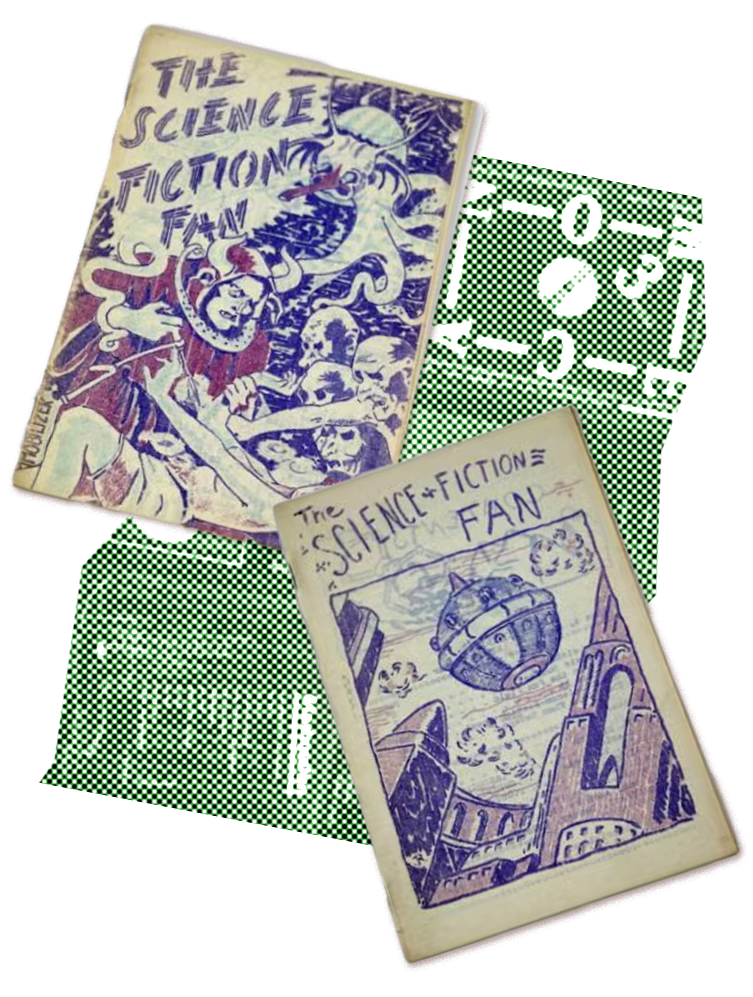

What is a Zine?
Zine being a shortened word for magazine means mini-magazine. A zine is a self-published, non-commercial print work that is typically produced in small, limited batches. Zines are traditionally hand made but are bound and printed in many ways. A zine can touch on a variety of topics from music and art, politics, sexuality, humor or self expression. Its content may vary from written, drawn, photographed or collaged works. While its structure can be narrative, journalistic, comic-like or abstract!


Early Beginnings: Sci-Fi Fans and DIY Publishing (1930s–40s)
The earliest recognizable zines emerged in the 1930s and 1940s, primarily within the realm of science fiction (sci-fi) fandom. Devoted fans of pulp science fiction magazines, such as Amazing Stories and Astounding Science Fiction, began creating and circulating their own homemade publications. These early fanzines allowed enthusiasts to critique, speculate, and expand upon the ideas presented in popular sci-fi literature.
One of the first recognized sci-fi fanzines was The Comet (1930), later followed by Science Fiction Digest and Fantasy Magazine. These publications were typed, mimeographed, and manually distributed by dedicated fans. While these early zines were often amateur in design and layout, they laid the groundwork for the zine culture that would flourish decades later.
The Influence of Dada and Surrealism
Though the zine movement as we know it took off in the mid-20th century, its spirit can be traced even further back to the Dada and Surrealist movements of the early 20th century. Dadaists, with their anti-establishment ethos, produced irreverent, chaotic, and handmade publications that challenged societal norms and questioned the meaning of art itself.
Artists like Tristan Tzara and Marcel Duchamp experimented with collage, typography, and visual storytelling to disrupt traditional forms of communication. These early avant-garde experiments created a blueprint for later zine makers who embraced a similar ethos—using art and words to confront, subvert, and redefine cultural narratives.
Zines Take Off: 1960s and 1970s Counterculture
The 1960s and 1970s witnessed a dramatic expansion of zine culture, fueled by the rise of countercultural movements and advancements in copying technology. The widespread availability of mimeograph and photocopy machines gave creators the power to produce and distribute their work cheaply and quickly. Zines no longer had to be meticulously handmade—though many still were—but could now be duplicated and circulated more widely.
During this period, zines began to reflect the growing dissatisfaction with mainstream politics, societal norms, and corporate media. Underground press publications like The East Village Other and Berkeley Barb blended radical politics, countercultural aesthetics, and experimental storytelling, further inspiring DIY publishing.
In the 1970s, the punk rock movement in both the U.S. and U.K. propelled zines into a new era. Punk zines, such as Sniffin’ Glue (UK) and Punk (NYC), captured the raw energy, anti-establishment attitude, and chaotic spirit of the punk scene. These zines served as platforms for reviewing music, documenting shows, and critiquing mainstream culture. They embodied the punk ethos of “do it yourself” (DIY), emphasizing that anyone with a typewriter, scissors, and a copier could create and share their voice.
Riot Grrrl and the Feminist Zine Explosion (1990s)
The 1990s saw another transformative wave in zine culture, particularly with the rise of the Riot Grrrl movement. Originating in the Pacific Northwest, Riot Grrrl was a feminist punk subculture that tackled issues of sexism, abuse, and inequality. Women and queer-identifying creators produced zines that challenged patriarchal norms and celebrated marginalized voices.
Zines like Bikini Kill, Girl Germs, and Jigsaw not only documented the movement but also became powerful tools for political activism and community building. They encouraged open dialogue about taboo topics like consent, mental health, and LGBTQ+ experiences—topics often ignored by mainstream media.


The Digital Shift: 2000s and Beyond
As the internet and digital platforms grew in the 2000s, zine culture faced both challenges and opportunities. Online forums and social media provided new avenues for artists to share their work, but some feared that the handmade nature of zines would be lost in the digital age. Despite this, zine culture persisted, adapting to new technologies while maintaining its DIY roots.
Many modern zine artists use a hybrid approach—designing content digitally but retaining the handmade, personal touch through physical print. Zine fests and art markets continue to thrive worldwide, keeping the spirit of independent publishing alive in the digital age.
Why Zines Matter Today
In an era where mainstream media and algorithm-driven content dominate, zines remain a vital form of expression. They provide a refuge for voices often marginalized by traditional publishing, offering an unfiltered space for ideas, stories, and art that challenge the status quo. Zines foster communities, build movements, and give creators the freedom to explore identity, politics, and culture in raw and authentic ways.
From science fiction enthusiasts in the 1930s to modern-day artists and activists, zines have always been about more than just ink and paper. These are a testament to the power of self-expression, reminding us that anyone with a story to tell has the tools to share it with the world—no gatekeepers required.